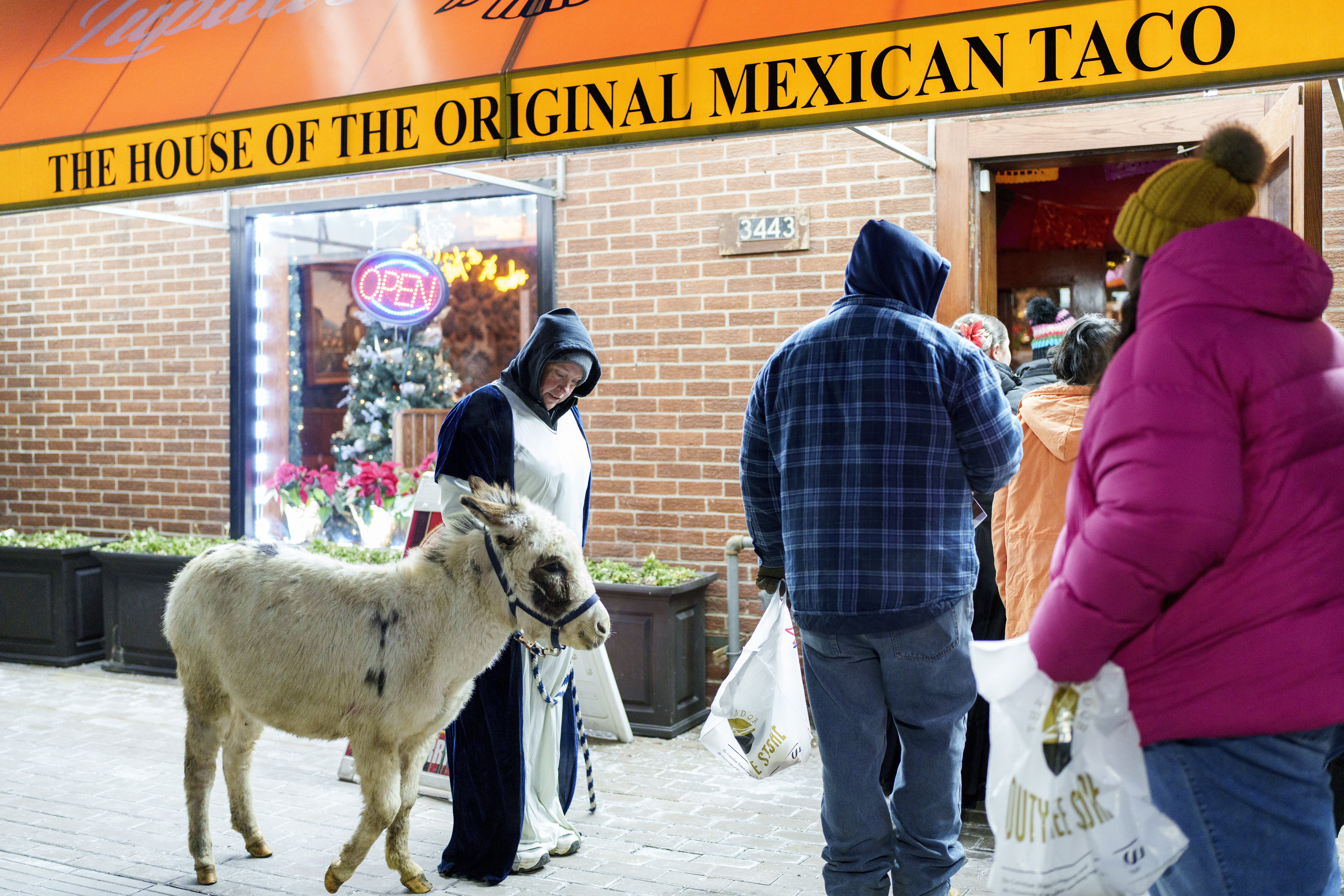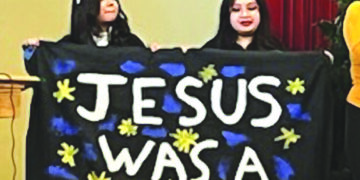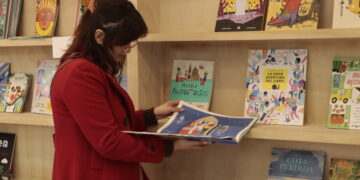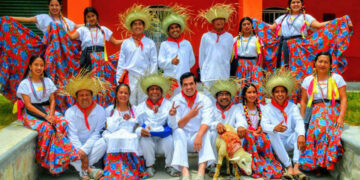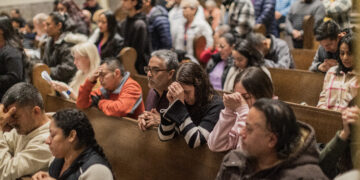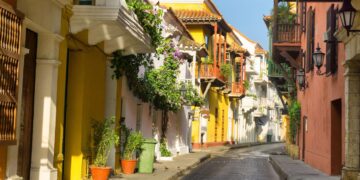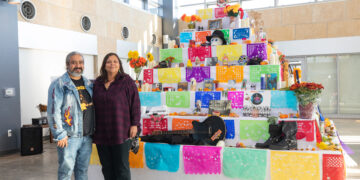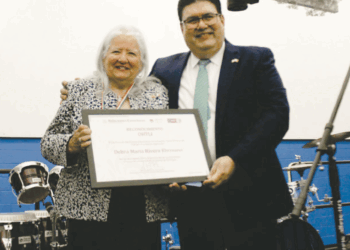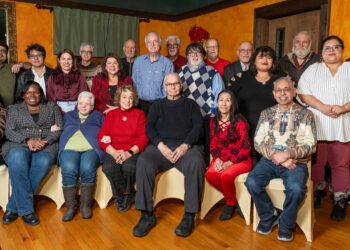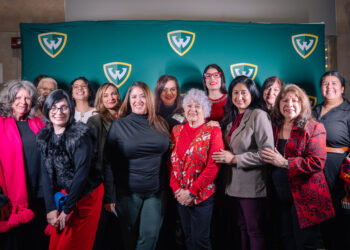By Ofelia Saenz with pictures by Alejandro Ugalde
As visitors to Playground Detroit enter the gallery, it’s hard not to be drawn in by the mural toward the back of the space. Tetris-like blocks of color in a limited palette, each showcasing a natural motif, plant the seed for what the viewer is about to experience. Rising above the room like the column of a tree, the mural stands surrounded by the pieces that make up artist Ivan Montoya’s new solo exhibition of paintings, “Semillas.” The exhibit runs now through Nov. 19, with an artist talk on Nov. 17.
The show title and theme were inspired by the Spanish saying, “hoy semillas, mañana flores,” which translates to “seeds today, flowers tomorrow.” In the exhibit, Montoya, who was born in Chihuahua, Mexico and emigrated to the U.S. with his family when he was five years old, pays homage to the sacrifices and dreams of immigrant families. “Semillas,” the Spanish word for “seeds,” explores the dynamics between first and second-generation immigrants and their parents.
“That saying can be a driving force for so many things,” says Montoya. “I feel like the pieces I’m painting are lessons, or semillas, I’ve taken on throughout my childhood. They just feel like things I need to share.”
“Semillas” seamlessly draws influence from many points along the Mexican ancestral timeline. Rounded shapes and scrunched forms recall the Mexican muralists of the first half of the twentieth century, but also remind us of figures fit onto panels in the art of the Mayans and Aztecs.
Montoya pulls from a breadth of color in the culture, not just painters, but artisans, textile makers, wood carvers and others.
“I try to pay respect to those influences and bring those colors forward in a contemporary way,” he says.
In “Semillas,” Montoya’s paintings often tell stories through allegory rather than direct narrative, and it calls out the mysticism intertwined with Mexican culture.
“A lot of my work is in a space that’s mystical, more fantastical and folkloric.”
In the piece “Setting of the Altar,” Montoya showcases a family carrying a wooden table teaming with food one might find in a Mexican household for Sunday dinner. There’s a pot that could be filled with posole, and a basket laid with elote. A molcajete holds peppers and tomatoes ready to be roasted and ground to salsa. There’s a bottle of Valentina and one of Don Julio. There’s everything familiar and foreign, as the figures carry the table reverently on their shoulders, the way a Virgin de Guadalupe might be carried in procession through the streets on Dec. 12.
Montoya says he named the piece “Setting of the Altar” because for the immigrant family, gathering for meals can sometimes feel sacred.
“The food they make, the dishes and recipes they bring with them are like offerings,” he says.
The visual language throughout “Semillas” is distinctly Mexican, even “Rito de Noche,” which is perhaps the biggest departure from the other paintings. Electric blue and lime green flames pulse between dancing figures that look like they could be lit by blacklight. But even though the environment of the piece is far more contemporary feeling, the story is not out of place with the other paintings. According to Montoya, the painting is a nod to the special camaraderie that first and second-generation immigrant young people feel with those who have the same lived experience as them – those who live in, as Montoya says, “the in-between space.” “Rito de Noche” is a place without inhibitions – a place without airs.
“You’re comfortable because you’re letting go,” says Montoya. “You’re not playing a role. You’re not being a son or daughter, or you’re not trying to assimilate or speak perfect English or be a certain person. You’re just letting go and being around people that are also letting go.”
The piece, he says, was inspired by his childhood connections with other Mexican American and Latino kids from throughout Metro Detroit. They were often connected through the limited number of Spanish-speaking masses offered throughout the area’s Catholic churches. Families often drove outside their communities to get to a Spanish-speaking mass, which allowed their children to form and grow bonds with other kids that they may not have otherwise met.
“We all kind of grew up and grew into adulthood together,” he says. “When we got together, we were speaking Spanglish, and making jokes that only we would get because they were kind of nodding to very specific things in Mexican American culture. That kind of belonging wasn’t forced. This circumstance was the only one where you could really just be, and not worry about who you are or who you might not be.”
For more information about the exhibit, visit www.PlaygroundDetroit.com or visit the artist’s website at www.IvanMontoya.art. For the most current show updates, follow the artist and the gallery on Instagram: @imontoya_ @playdetroit
A native of Southwest Detroit, Ofelia Saenz is a writer, marketer and food entrepreneur. Now that her son Ruben is off to college, she’s working to teach her Chihuahua/Pekingese, Memo, to be less messy and more friendly. She makes killer tamales.

